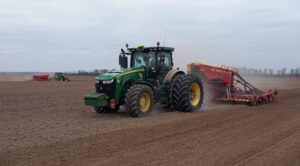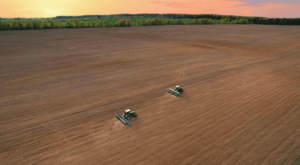
Agrotrade has started sowing winter crops for the 2025 harvest on 27.9 thousand hectares, the company’s press service reports on its Facebook page.
According to the report, the sowing campaign started with winter rapeseed, for which almost 12.5 thou hectares have been allocated in Kharkiv, Chernihiv, Sumy and Poltava regions, which is 1.3 thou hectares more than last season.
“The change in the area under winter rapeseed is primarily due to crop rotation requirements. This year, we started the sowing campaign simultaneously in Kharkiv, Sumy and Chernihiv regions. The work has already gained momentum and will last a total of two weeks. They were preceded by high-quality preparation, such as peeling, plowing, leveling and fertilizing,” said Oleksandr Ovsyanyk, Director of Agrotrade’s Agricultural Department.
Currently, more than 24% of the planned area has been sown with the crop, and 15 units of machinery are involved.
“We will soon start sowing winter wheat, for which Agrotrade has allocated 15.4 thousand hectares,” the agricultural holding summarized.
The Agrotrade Group is a vertically integrated holding company with a full agro-industrial cycle (production, processing, storage and trade of agricultural products). It cultivates over 70 thousand hectares of land in Chernihiv, Sumy, Poltava and Kharkiv regions. Its main crops are sunflower, corn, winter wheat, soybeans and rapeseed. It has its own network of elevators with a simultaneous storage capacity of 570 thousand tons.
The group also produces hybrid seeds of corn and sunflower, barley, and winter wheat. In 2014, a seed plant with a capacity of 20 thousand tons of seeds per year was built on the basis of Kolos seed farm (Kharkiv region). In 2018, Agrotrade launched its own brand Agroseeds on the market.
Vsevolod Kozhemiako is the founder and CEO of Agrotrade.

The agricultural holding Continental Farmers Group has started the first wave of harvesting winter crops, which are grown on 89.5 thou hectares, the press service of the agricultural holding reports.
According to the report, in the season-2024, the agroholding’s winter wheat area is 43.2 thou hectares, winter rapeseed – 33.4 thou hectares, winter barley – 12.9 thou hectares.
Continental started the harvest with threshing of winter barley in the Lviv cluster, followed by the harvest in the Galych, Bukovyna and Tsentr clusters. Once barley harvesting is complete, winter rapeseed threshing will begin in the first ten days of July. Winter wheat harvesting is expected to start in mid-July, the agricultural holding said.
According to Konstantin Shityuk, COO of Continental Farmers Group, due to the peculiarities of this spring and the extended vegetation of winter crops, the agricultural holding expected a very early start of the harvest. However, the situation was changed by a prolonged drought in May, and only in early June did farmers across the western region receive sufficient rainfall to normalize the duration of crop development.
“We still started barley harvesting much earlier than average: the June rainfall had little impact on its development. However, winter rape and winter wheat harvesting will start as usual in July. We were preparing for this year’s harvesting campaign with great seriousness given the significant uncertainties associated with the possibility of truck traffic, movement of equipment, changes in mobilization legislation, etc. There were difficulties in the supply of spare parts and disruptions in logistics, but in general, we managed to prepare the equipment, secure resources and get 100% ready for the start in the spring,” explained Shityuk.
The agricultural holding noted that Continental’s elevator facilities are equipped with generators to ensure uninterrupted operation during power outages and are fully prepared to receive early crops. The agricultural holding is also fully provided with the necessary machinery for harvesting: the share of leased units has not increased compared to previous years and is about 15%.
“The only issue that could negatively affect the harvesting campaign is the provision of trucks for harvesting, as most carriers do not belong to the critical infrastructure sector,” Continental summarized.
Mriya Agroholding and CFG, united under the name Continental Farmers Group, have been operating as a single business since November 2018, when Mriya entered into an agreement with international investor Salic UK to sell its assets.
Salic was founded in 2012. Its sole shareholder is the Saudi Arabian Public Investment Fund, which invests in agricultural and livestock production.

Astarta Agro-Industrial Holding, the country’s largest sugar producer, has allocated 29% of its production area to winter crops, according to a report on the Warsaw Stock Exchange on Thursday.
According to the report, winter wheat was sown on 49 thousand hectares, up 14% from a year earlier, and winter rapeseed on 12 thousand hectares, down 12% from last year.
“During the sowing campaign, the area under winter wheat was adjusted from 54 thou hectares to 49 thou hectares due to dry weather conditions to complete the sowing campaign in the optimal time,” the agroholding explained.
At the same time, oilseed harvesting is nearing completion. The gross harvest of sunflower amounted to 83 thsd tonnes with a yield of 3.0 t/ha, which is the same as last year, and soybeans – 169 thsd tonnes with a yield of 3.1 t/ha, which is 6% more than in 2022. Corn and sugar beet harvesting is 2/3 complete.
“Astarta also estimated its share in Ukraine’s exports of grains and oilseeds at 1% based on the results of 9M2023.
“Astarta is a vertically integrated agro-industrial holding company operating in eight regions of Ukraine. It comprises six sugar factories, agricultural enterprises with a land bank of 220 thousand hectares and dairy farms with 22 thousand cattle, an oil extraction plant in Globyno (Poltava region), seven elevators and a biogas complex.
In the third quarter of 2023, the agricultural holding earned EUR1.24 million in net profit, down 27.7 times compared to the same period in 2022. Astarta’s revenue decreased by 14.4% to EUR104.75 million, gross profit by 2.7 times to EUR26.96 million, operating profit by 7.6 times to EUR6.79 million, and EBITDA by 42.7% to EUR97.25 million.
Due to significantly better performance in the first half of this year compared to the first half of last year, in the first 9 months of 2023, net profit decreased by 9.8% to EUR 55.97 million, while revenue increased by 14.8% to EUR 392.00 million. The company’s gross profit increased by 3.0% to EUR 151.91 million, while operating profit decreased by 15.9% to EUR 79.91 million and EBITDA by 10.8% to EUR 116.63 million.

Ukraine continues sowing winter crops, which have already been planted on 3.7 million hectares compared to 2.992 million hectares a week earlier, the Ministry of Agrarian Policy and Food reported.
According to the report, over the past week, farmers sowed 2583 thousand hectares of winter crops (764.7 thousand hectares a week earlier), of which wheat was sown on 2352 thousand hectares (1.743 million hectares), barley – 171 thousand hectares (109 thousand hectares), rye – 60 thousand hectares (53.6 thousand hectares).
The Ministry of Agrarian Policy noted that the agrarians of Sumy region are leading in sowing of winter crops – 97% of the forecast. The leaders in wheat sowing are Dnipropetrovska oblast with 271.3 thou hectares, barley – Mykolaivska oblast with 25 thou hectares, rye – Volynska oblast with 13 thou hectares.
Winter rapeseed sowing is nearing completion in all regions. The area under the crop is 1.111 mln ha (1.087 mln ha), which is 91.7% of the plan. Dnipropetrovs’k and Odesa regions are the leaders in sowing of winter rapeseed with 117.3 thou hectares and 103.6 thou hectares respectively.
As reported with reference to the survey conducted by the Ministry of Agrarian Policy, the vast majority of farmers do not plan to significantly change the area under winter crops in 2024 compared to the previous season.

Due to the drought observed in Ukraine, autumn winter crops have already been partially lost, at the same time, the prolonged lack of precipitation intensifies the pace of the harvesting campaign and contributes to high quality corn grain, according to the analytical cooperative “Pusk”, established within the framework of the All-Ukrainian Agrarian Rada (VAR).
“The forecast model does not show precipitation in Ukraine in the near future. Therefore, the moisture content of corn grain remains low, averaging 17-20%, while in the past season it was 30-35%. This will help reduce the cost of corn grain, as one drying cycle is enough for the harvested crop,” analysts said.
They noted that in early October, agrarians will intensify the collection of corn, because they will complete the harvesting of sunflower and soybeans.
At the same time, it is noted that the shelling of ports in Odessa and Danube region hinders the export of corn. At the same time, this product is in demand from China exclusively on CIF basis with delivery in October-December at a conditional price of $250/ton.
“On all bases weekly price tags for Ukrainian corn lose 3-5$/ton. The supply of its grain is high, but logistical problems are and will continue to be a factor in the fall of prices, especially in the deployment of the harvesting campaign”, – explained in the CAP and added that in a week we can expect the following level of prices for 1 ton of corn: SRT river ports – 140-150$, DAP border – 145-155$.

Agrarians in all regions except Transcarpathia have sown 1155 thousand hectares of winter crops, of which 905.9 thousand hectares are allocated for winter rape and 249 thousand hectares for winter grains, the press service of the Ministry of Agrarian Policy and Food reports.
According to the report, 228.6 thou hectares are already under winter wheat, 10.8 thou hectares under winter barley, and 9.5 thou hectares under winter rye.
Over the previous week, 251 thou hectares were planted with winter rape, and 204 thou hectares with winter grain.
In addition, it is reported that farmers of Volyn, Poltava, Rivne, Sumy, Ternopil, Chernivtsi regions have completed sowing of winter rape.
Most of the winter grains were sown in Sumy region – 25.9 thousand hectares, which is 50% of the forecast, winter rapeseed – in Dnipropetrovs’k region, 93.4 thousand hectares (74.4% of the forecast).
As reported with reference to the survey conducted by the Ministry of Agrarian Policy, the vast majority of farmers do not plan to significantly change the area under winter crops in 2024 compared to the previous season.